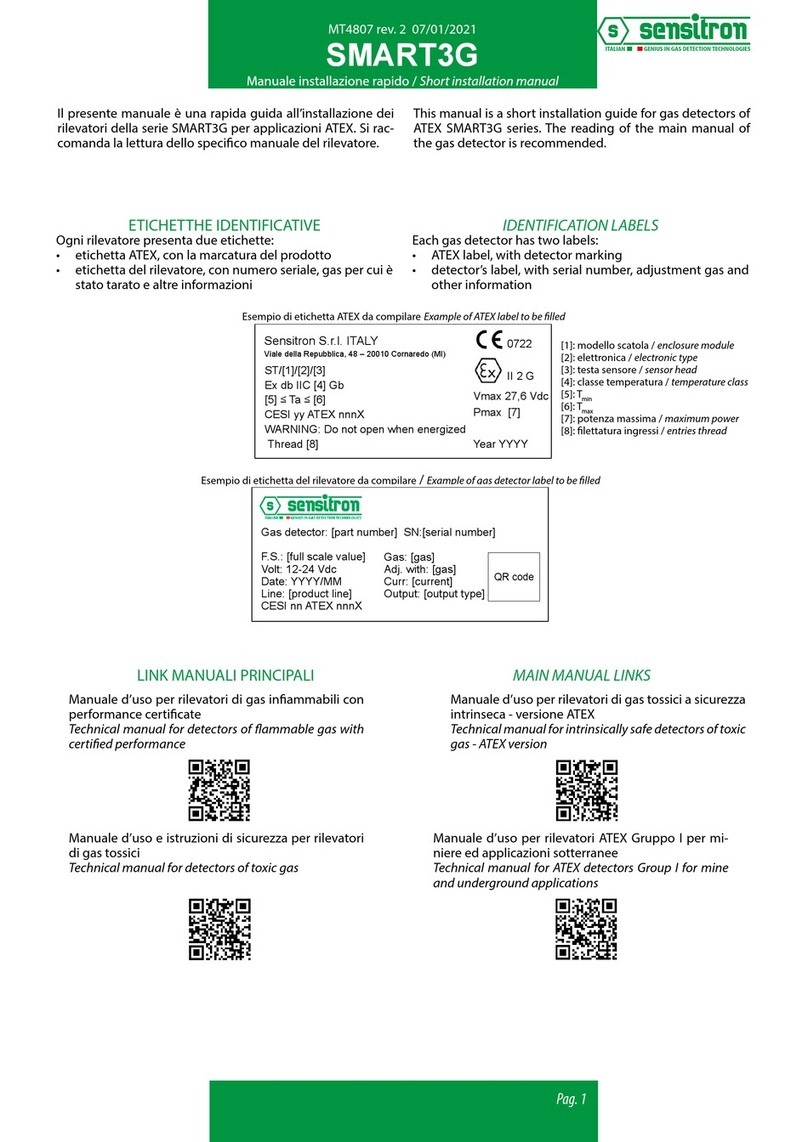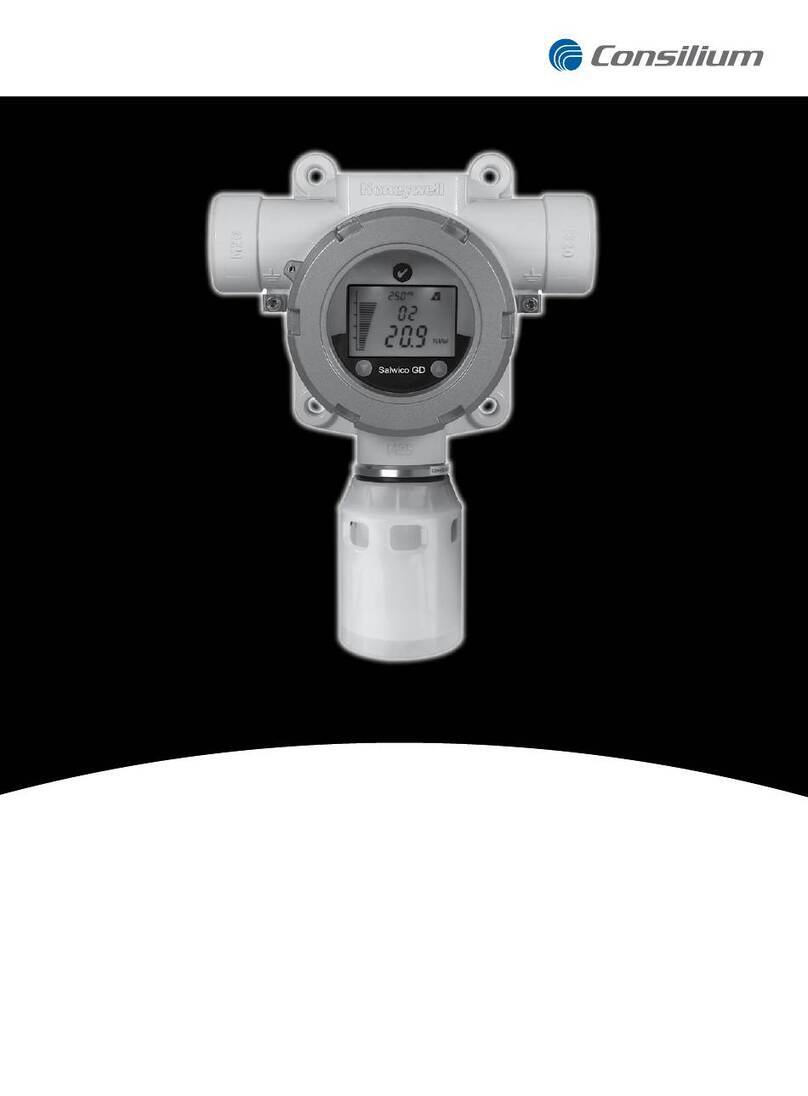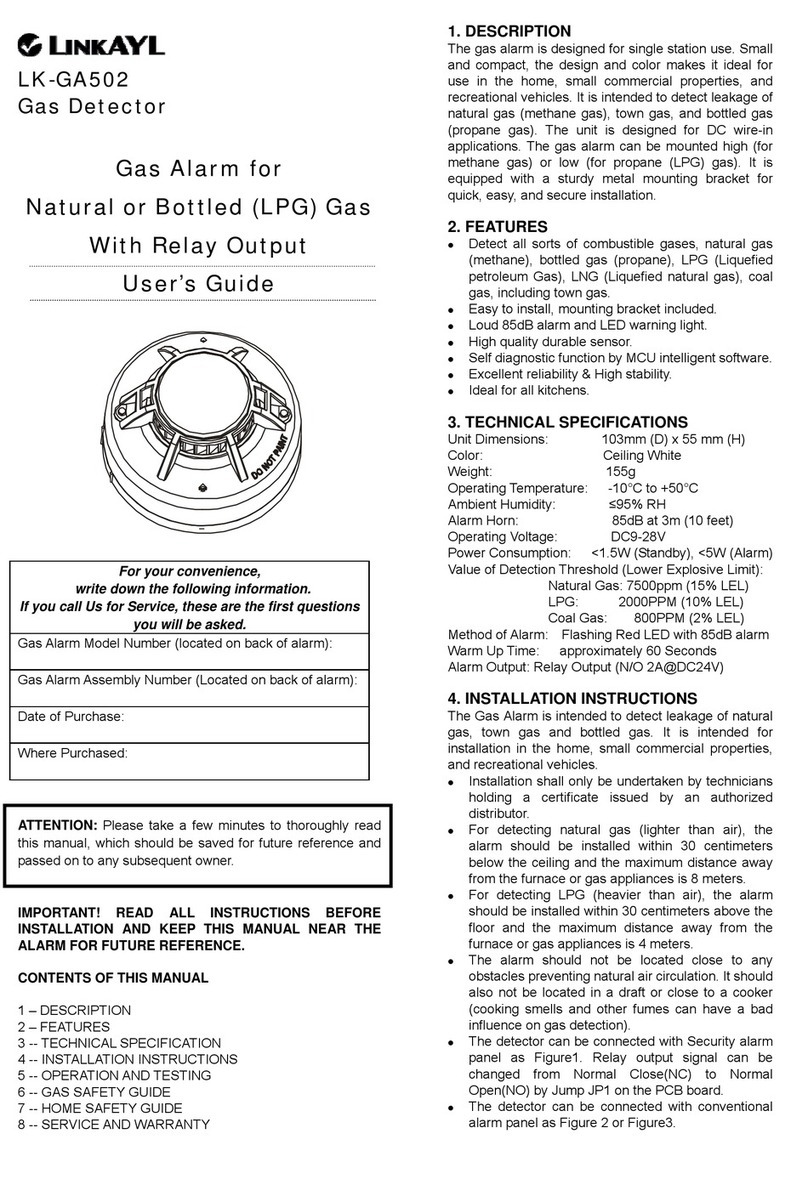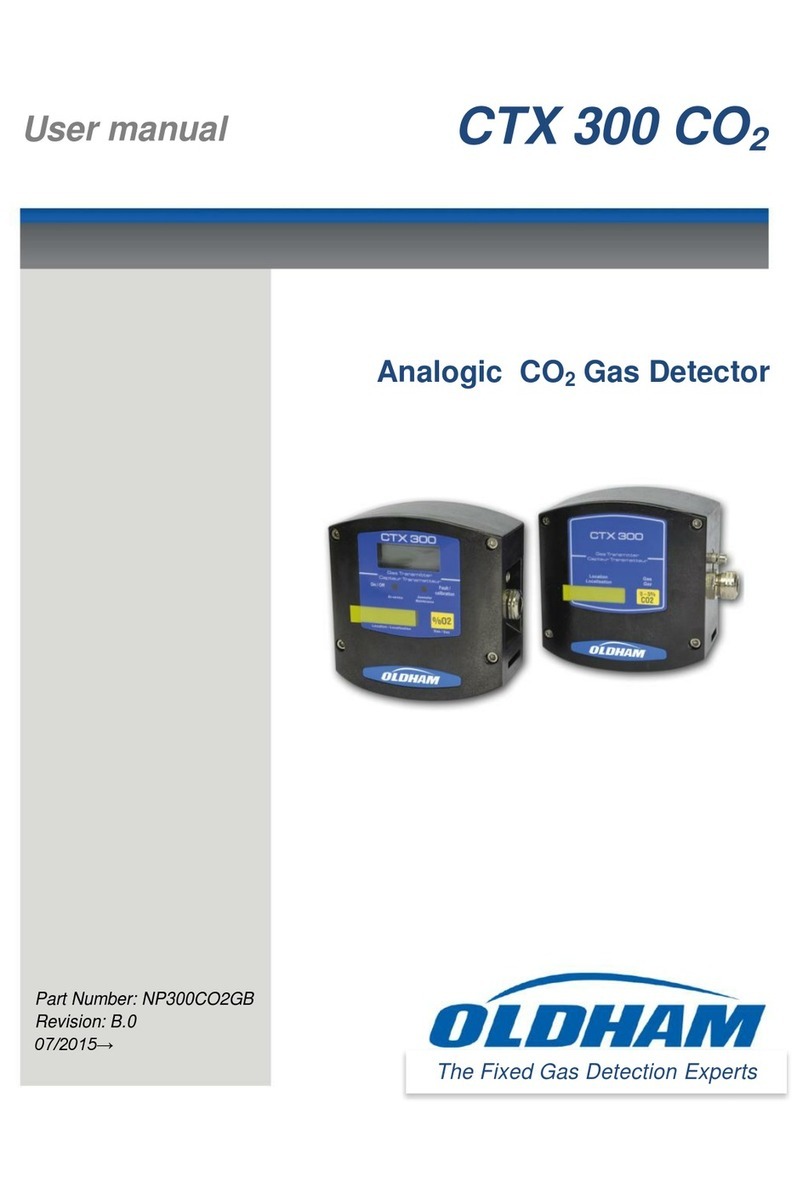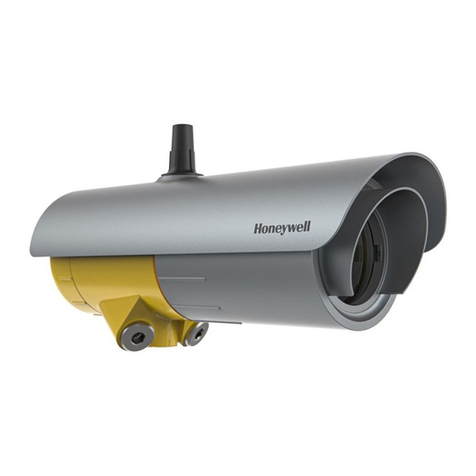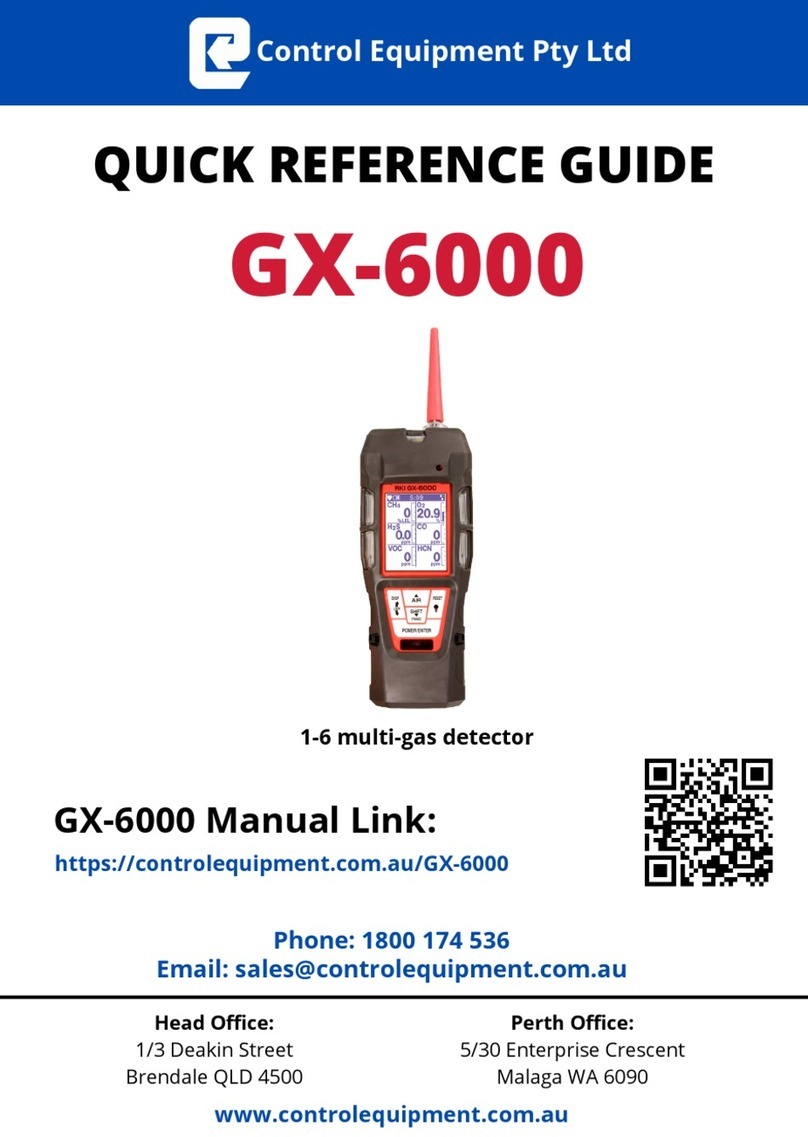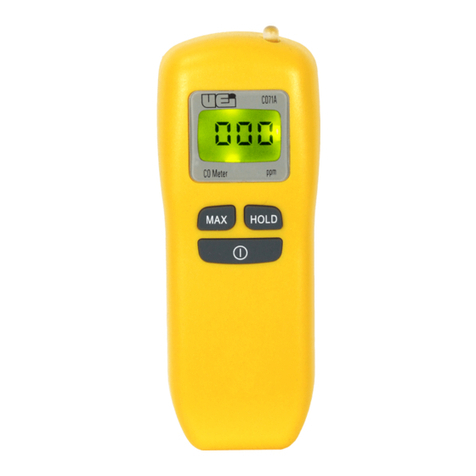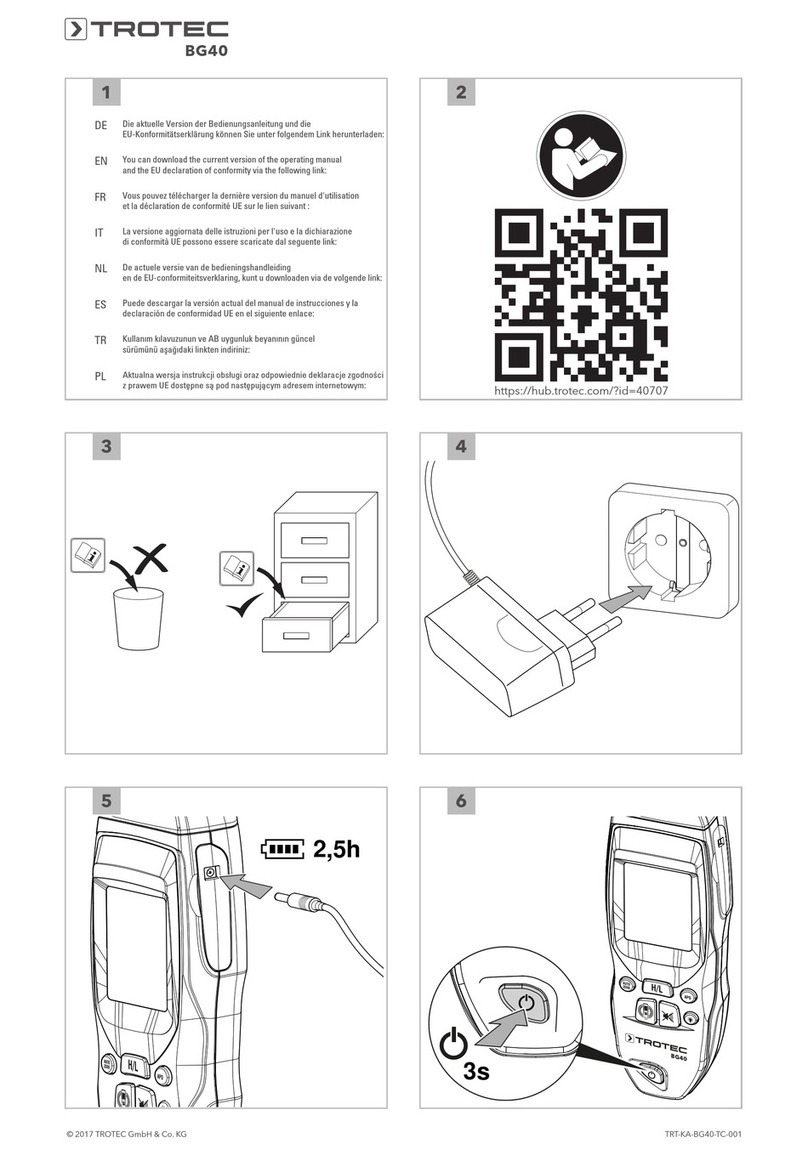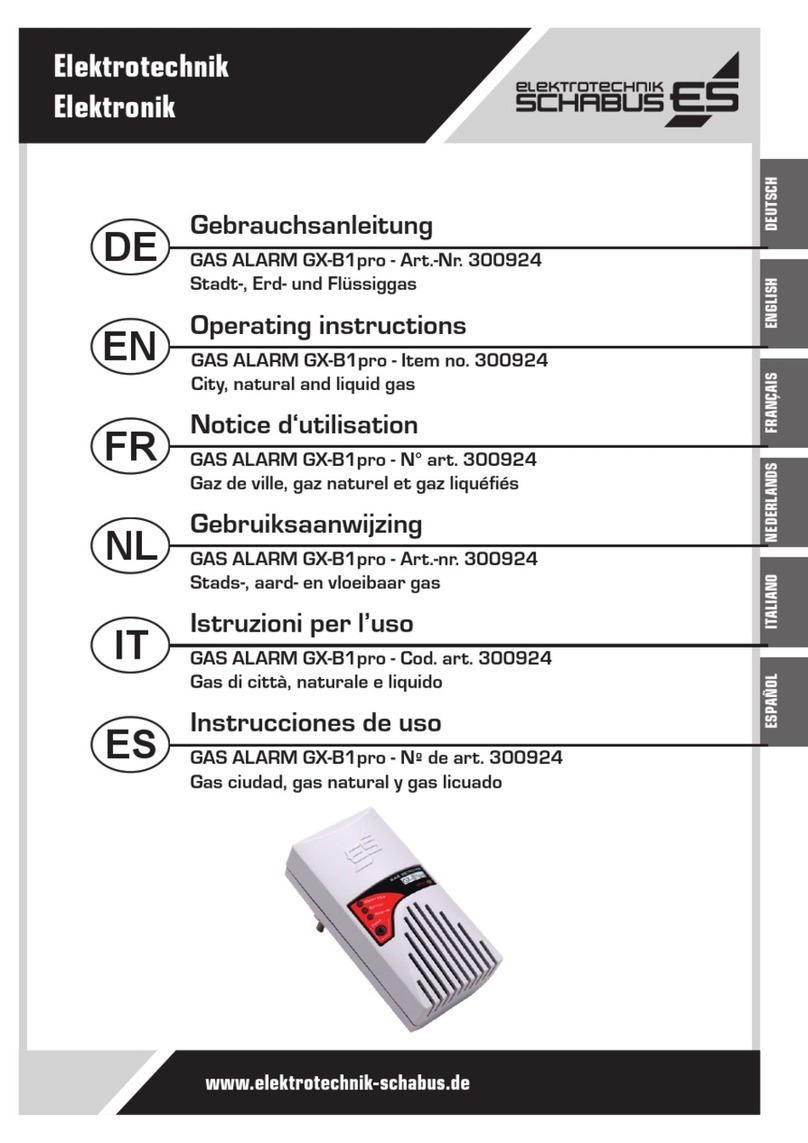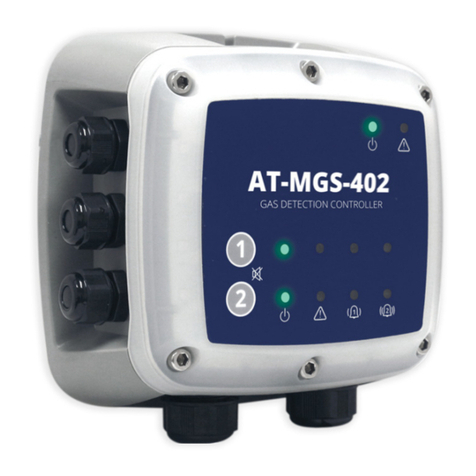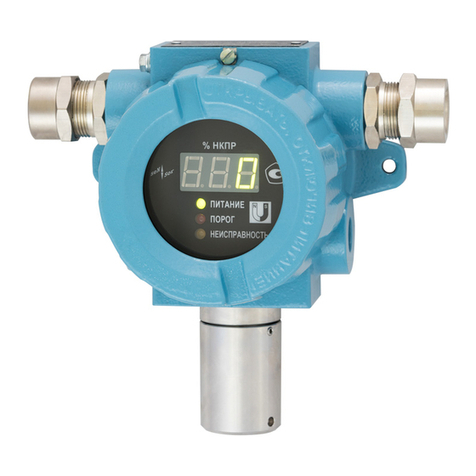Bellman & Symfon BE1555 User manual

BE1555 VISIT CO DETECTOR

Overview
RADIO
ALARM
FAU LT
POWER TEST
&
HUSH
CARBON
MONOXIDE
ALARM
Alarm horn Test/hush button
Radio button
Sealed battery
CO Sensor
Blue
Red
Yellow
Green
BE1555
Medical device information 6
Installation 10
Signal pattern 11
Changing the radio key 12
Facts about carbon monoxide 14
Location and positioning 16
Monitoring, testing and maintenance 20
What to do when the alarm sounds 22
Troubleshooting 28
Service and support 29
Contents
EN
4 5

Read this rst
Thank you for choosing a product from Bellman & Symfon – the world leader in alerting
systems based in Gothenburg, Sweden. This user guide contains important medical device
information. Please read it carefully to make sure that you understand and get the best out of
your Bellman & Symfon product. If you are just installing the unit, the booklet must be given to
the householder. For more information about features and benets, contact your hearing care
professional.
About the BE1555 Visit CO detector
Intended purpose
This device is part of the Visit alerting system. The intended purpose of the system is to alert deaf
and hard of hearing people of important signals in their home. The CO detector is activated by
toxic levels of carbon monoxide in the home and sends a signal to the Visit receiver that warns
the user with sound, ashes or vibrations.
Intended user group
The intended user group consists of people of all ages with mild to severe hearing loss or
deafness that need audio, visual or sensory amplication of carbon monoxide alarms.
Intended user
The intended user is a person with mild to severe hearing loss or deafness.
Principle of operation
The Visit alerting system consists of a set of wirelessly connected transmitters and receivers
that are located across the home. When a transmitter detects an activity, it signals the Visit
receiver that alerts the user with sound, ashes or vibrations. In order to use the system, you
need at least one transmitter and one receiver.
This device will not restore normal hearing and will not prevent or improve a hearing
impairment or deafness resulting from organic conditions.
Regulatory symbols
With this symbol, Bellman & Symfon conrms that the product meets the Medical
Device Regulation EU 2017/745.
This symbol indicates the manufacturer’s serial number so that a specic medical
device can be identied. It’s available on the product and gift box.
This symbol indicates the manufacturer’s catalogue number so that the medical
device can be identied. It’s available on the product and gift box.
This symbol indicates the medical device manufacturer, as dened in
EUDirectives90/385/EEC, 93/42/EEC and 98/79/EC.
This symbol indicates that the user should consult this instruction guide.
This symbol indicates that it is important for the user to pay attention to the
relevant warning notices in the user guides.
This symbol indicates important information for handling and product safety.
Temperature during transport and storage: -10° to 40° C, 14° to 104° F
Temperature during operation: -10° to 40° C, 14° to 104° F
6 7
EN

Compatible Visit receivers
BE1450 Visit portable receiver
BE1441 Visit ash receiver
BE1442 Visit ash receiver
BE1580 Visit alarm clock receiver
BE1470 Visit pager receiver
BE1560 Visit wrist receiver
Conguration options
This device can be congured with the following Visit receivers:
This CO detector is equipped with a radio module that transmits radio signals to one or
several supplementary Visit receivers. A Visit receiver will help to ensure that the alarm
is noticed throughout the property. The alert and signal pattern for the Visit receiver is
explained in the product’s user manual.
Compliance information
Hereby Bellman & Symfon declares that, in Europe, this product is in compliance with the essential
requirements of the Medical Device Regulation EU 2017/745 as well as the directives and regula-
tions listed below. The full text of the declaration of conformity can be obtained from Bellman &
Symfon or your local Bellman & Symfon representative. Visit bellman.com for contact information.
ISO Certication of legal manufacturer
Bellman is certied in accordance with SS-EN ISO 9001 and SS-EN ISO 13485.
SS-EN ISO 9001 Cert. No: CN19/42071, SS-EN ISO 13485 Cert. No.: CN19/42070
Certication Body
SGS United Kingdom Ltd, Rossmore Business Park Ellesmere Port Cheshire CH65 3EN UK
Humidity during transportation and storage: <95%, non-condensing
Humidity during operation: 15% to 95%, non-condensing
Operating
conditions
This device is designed such that it functions without problems or restrictions if used
as intended, unless otherwise noted in the user guide or this leaet.
With this CE symbol, Bellman & Symfon conrms that this product meets EU stan-
dards for carbon monoxide detectors, safety and environmental protection as well as
the Radio Equipment Directive (RED).
With this Kitemark symbol, Bellman & Symfon conrms that this product has been test-
ed and approved to the requirements set out by the British Standards Institute (BSI).
This symbol indicates that the product shall not be treated as household waste.
Please hand over your old or unused product to the applicable collection point for
the recycling of electrical and electronic equipment or bring your old product to
your hearing care professional for appropriate disposal. By ensuring this product is
disposed of correctly, you will help prevent potential negative eects on the environ-
ment and human health.
Radio Equipment Directive (RED)
Medical Device Regulation (MDR)
Restriction of Hazardous Substances
Directive (RoHS)
REACH Regulation
EC General Product Safety Directive
Waste Electrical & Electronic Equipment
(WEEE)
EC Battery Directive
Electrical apparatus for the detection of
carbon monoxide in domestic premises
8 9
EN

Installation
Make sure to select a location complying with the advice in Location and positioning.
1Remove the mounting bracket from the CO alarm by turning it counter-clockwise.
2Taking care to avoid any electrical wiring, x the mounting bracket to the ceiling or wall
using the supplied screws and plugs.
3Fit the alarm to the bracket by turning it clockwise until is snaps into place. The red, yellow
and green LEDs blink in sequence to show that the unit is on.
Testing the connection
1Wait 15 s. Press the test/hush button and
release it when the alarm sounds. The CO
alarm transmits a radio signal to the receiver.
2The orange and red LEDs on the Visit receiver
blink alternately to show that the signal was
received. In addition, it starts to sound, ash or
vibrate depending on the receiver.
1 2
1 2 3
Signal pattern
When the alarm detects over 43 ppm CO, the red LED blinks in accordance with the table. This
helps locate CO leaks as the alarm gives an indication straight away. This pre-alarm signal may
be triggered by CO coming from e.g. cooking with gas, car engines or nearby barbecues. This
is usually not a concern, unless the pre-alarm signal persists until the alarm sounds and the
CO source is unknown. Note that the alarm may sound if cigarette smoke is blown into it, or
aerosols are released nearby.
Depending on the cause of the alarm, the signal patterns are as follows:
CO level / fault Alarm LED Alarm sound Visit receiver
> 43 ppm 1 red blink every 2 s On within 60 – 90 min Alarm within 60 – 90 min
> 80 ppm 2 red blinks every 2 s On within 10 – 40 min Alarm within 10 – 40 min
>150 ppm 4 red blinks every 2 s On within 2 min Alarm within 2 min
Low battery 1 yellow blink / min 1 beep / min Blinking red LED
Faulty unit 2 yellow blinks / min 2 beeps / min Blinking red LED
End of Life 3 yellow blinks / min 3 beeps / min Blinking red LED
When the low battery warning occurs for the rst time, you have at least 30 days to replace it.
You can press the test button to temporarily hush the low battery warning for 24 hours.
Using broadcast
If you want the alarm signal to be transmitted to all Visit receivers within radio range, you can
activate broadcast mode. This will override the radio key settings.
1Remove the alarm from the bracket to access the radio button, see Overview.
2Press the radio button three times in quick succession. The radio LED blinks three times in
blue to show that broadcast is activated.
The alarm will stop sounding shortly after the button is
released and the Visit receiver will time out in less than a minute.
10 11
EN

12 13
Changing the radio key
If your Visit system is activated for no reason, there is probably a nearby system that triggers
yours. In order to avoid radio interference, you need to change the radio key on all units.
Systems with dierent types of transmitters
Change the radio key on all other transmitters in the system by moving any of the radio key
switches, see the corresponding transmitter user manual.
Changing the radio key on the BE1555 CO alarm
1Remove the alarm from the bracket to access the radio button, see Overview.Press and
hold the radio button until the radio LED blinks slowly in blue. Release the button.
2Press the test button on any other transmitter within 30 s to transmit the new radio key.
3The radio LED on the alarm lights up in blue to show that the radio key has been changed.
1 2 3
RADIO
ALARM
FAU LT
POWER TEST
&
HUSH
CARBON
MONOXIDE
ALARM
Changing the radio key on a receiver
1Press and hold the test/function button on the Visit receiver until the green and yellow LEDs
blink alternately, see image on the next page. Release the button.
2Within 30 s, press the test/hush button and release it when the alarm sounds to transmit the
new radio key.
3All LEDs on the receiver blink 5 times to show that the radio key has been changed.
RADIO
ALARM
FAU LT
POWER TEST
&
PUSH
CARBON
MONOXIDE
ALARM
RADIO
ALARM
FAU LT
POWER TEST
&
PUSH
CARBON
MONOXIDE
ALARM
Systems with only BE1555 CO alarms
Changing the radio key on the CO alarms
Select one of the BE1555 CO alarms that will function as the master unit. The other alarms will
function as slave units. Remove the CO alarms from the brackets to access the radio button.
1Press and hold the radio button on the master unit until the radio LED blinks slowly in blue. Press
and hold the button again to generate a new radio key. The radio LED will pulsate to conrm.
2Press and hold the radio button on the slave unit until the radio LED blinks slowly in blue.
3Press the test/hush button on the master unit and realese it when the alarm sounds to
transmit the new radio key.
4The radio LED on the slave unit lights up in blue to show that the radio key has been changed.
Repeat steps 2 – 4 to change the radio key on an additional BE1555 CO alarm.
Changing the radio key on a receiver
1Press and hold the test/function button on the Visit receiver until the green and yellow LEDs
blink alternately, see image on the next page. Release the button.
2Within 30 s, press the test/hush button and release it when the alarm sounds to transmit the
new radio key.
3All LEDs on the receiver blink 5 times to show that the radio key has been changed.
5
1 2 3
RADIO
ALARM
FAU LT
POWER TEST
&
PUSH
CARBON
MONOXIDE
ALARM
EN

14 15
EN
Carbon monoxide – the silent killer
What is carbon monoxide?
Many people are killed each year, and many more suer ill health from carbon monoxide
(CO) poisoning. CO is an invisible, odourless, tasteless and extremely toxic gas. It is produced by
appliances and vehicles burning fuels, such as coal, oil, natural/bottled gas, paran, wood, pet-
rol, diesel, charcoal etc. CO is absorbed by red blood cells in the lungs in preference to oxygen
- this results in rapid damage to the heart and brain from oxygen starvation.
High levels of CO in a house can be caused by:
Incorrectly or poorly installed fuel-burning appliances.
Blocked or cracked chimneys/ues.
Blocked vents or draught-proong which makes areas with fuel burning appliances or
replaces airtight.
Engines of cars, lawnmowers etc. left running in conned spaces.
Portable paran or gas heaters in badly ventilated rooms.
What happens when your CO alarm detects carbon monoxide?
When the CO alarm detects potentially dangerous levels of CO, it blinks the red alarm
light immediately and then sounds a loud alarm if the CO persists. The Signal pattern ta-
ble on page 28 shows how the CO alarm reacts to dierent levels of CO gas and exposure
time. At higher levels of CO, the alarm turns on sooner. The rate of blinking of the red LED
indicates the level of CO. If your CO alarm sounds, follow the instructions in the section
What to do when the alarm sounds.
NEVER IGNORE THE ALARM!
Symptoms of CO poisoning
Approximate inhalation time
and symptoms developed
The maximum allowable concentration for continuous exposure in any 8 h
period according to OSHA*.
Slight headache after 1.5 h.
Slight headache, fatigue, dizziness, nausea after 2 – 3 h.
Frontal headaches within 1 – 2 hours, life threatening after 3 h, also
maximum parts per million in ue gas (on an air free basis) according
to US Environmental Protection Agency.
Dizziness, nausea and convulsions within 45 min.
Unconsciousness within 2 hours. Death within 2 – 3 h.
Headache, dizziness and nausea within 20 min. Death within 1 h.
Headache, dizziness and nausea within 5 – 10 min. Death within 25 – 30 min.
Headache, dizziness and nausea within 1 – 2 min. Death within 10 – 15 min.
Death within 1 – 3 min.
CO (ppm*)
concentration
35
150
200
400
800
1600
3200
6400
12800
* ppm = parts per million
** OSHA = Occupational Safety & Health Association

16 17
EN
Location and positioning
The installation of this CO alarm should not be used as a substitute for proper installation,
use and maintenance of fuel burning appliances including appropriate ventilation and
exhaust systems.
Ideally a CO alarm should be installed in every bedroom, in every room containing a fuel
burning appliance and in remote rooms where occupants spend a considerable amount of
time. However, if the number of CO alarms to be tted is limited, the following points should
be considered when deciding where best to t the alarm(s):
If there is an appliance in a room where people sleep, place a CO alarm in this room.
Locate a CO alarm in a room containing a ueless or open-ued appliance.
Locate a CO alarm in a room where the occupant(s) spend most of their time.
In a bedsit, the CO alarm should be placed as far away from the cooking appliance as possi-
ble, but near to where the person sleeps.
If the appliance is in a room not normally used, such as a boiler room, the CO alarm should
be placed just outside the room so that the alarm will be heard more easily.
Unsuitable Locations
Do not place the CO alarm in any of the following areas:
Outside the building.
In the immediate vicinity of a cooking
appliance (keep it at least 1 m horizon-
tally from it).
In an enclosed space (e.g. in or below a
cupboard).
In a damp or humid area.
Next to a door, window, air vent or
anywhere that it would be aected by
draughts.
Where it would be obstructed, e.g. by
curtains or furniture.
Directly above a sink or cooker.
Over heat sources such as radiators or
hot air vents.
In an area where the temperature could
drop below -10°C or rise above 40°C.
In a bathroom or other areas where
the CO alarm may be exposed to water
splashes, dripping or condensation (e.g.
above an electric kettle).
Next to an extractor fan.
Where dirt or dust could block the
sensor.
Near paint, thinners, solvent fumes or air
fresheners.
Where it could be easily knocked or
damaged, or where it could be acciden-
tally turned o or removed.
A room with a fuel burning appliance, see Figure 1
If it is mounted on a wall, it should be located at a height greater than the height of any door
or window but still be at least 150 mm from the ceiling.
If it is mounted on the ceiling it should be at least 300 mm from any wall or light tting.
The CO alarm should be a horizontal distance of between 1 m and 3 m from the potential CO
source.
If there is a partition in the room, the CO alarm should be located on the same side of
the partition as the potential source.
In rooms with sloped ceilings, the CO alarm should be located at the high side of the room,
see Figure 2.
A bedroom or a room remote from a fuel burning appliance, see Figure 3
Mount the CO alarm relatively close to the breathing zone of the occupants. Whatever position you
choose, make sure it is possible to view the three LED indicators, when in the vicinity of the alarm.
Do not use the CO alarm on an intermittent basis, or as a portable detector for the leak-
age of combustion products from fuel burning appliances or chimneys.

18 19
EN
150 mm
300 mm CO alarm CO alarm
1–3 m
1–3 m
Dead air,
don’t locate
here
Figure 1
Room with a fuel
burning appliance
Figure 2
Rooms with sloped
ceilings
Figure 3
Bedrooms/rooms remote from source
300 mm CO alarm
CO alarm
Breathing
level
Caravans and boats
Caravans and boats may have additional risks of carbon monoxide ingress through air vents
due to the nearby presence of other vehicles, engines, generators or barbecues, however this
does not change the basic guidance on location of the alarm. Caravans and boats should be
tted with an alarm in the same room as any combustion appliance(s), located in accordance
with the Location and positioning section. lf the caravan or boat has a single living space
which incorporates the sleeping accommodation, it can be considered to be equivalent to
a bedsit, and a single alarm is sucient. However, any sleeping accommodation which is in
a separate room from the combustion appliance(s) should also contain an alarm, located in
accordance with Figure 3.
Choosing locations in caravans and boats
It is not always possible to nd an optimum location for an alarm, for example, a small car-
avan or boat may not have suitable vertical surfaces available. Nevertheless, when tting
an apparatus in such situations, the two most important considerations when selecting
an appropriate location are:
not mounting the apparatus directly above a source of heat or steam; and
mounting the apparatus at a distance of 1 – 3 meters from the nearest edge of the
potential source.
Interfering substances
The apparatus should not be exposed to excessive amounts of fumes from petrol, diesel,
solvents, greases, alcohols and organic cleaning uids.
The apparatus may respond to brief exhaust gas emissions e.g. during initial start-up of
an appliance or engine.
Hydrogen acts as an interferent and may give rise to alarms. Hydrogen can arise from some
battery charging activities and also the curing of concrete under certain circumstances.

20 21
EN
Monitoring
The CO alarm self-checks vital functions to ensure that it is operating correctly.
1Low battery fault – the battery voltage is measured and compared against a low voltage
threshold.
2Sensor Fault – the sensor is checked for electrical continuity and open circuit.
3End of life fault – The alarm is programmed to check when the useful life of the alarm has
been exceeded.
Low battery
If the battery is starting to be depleted, the CO alarm beeps, the yellow LED blinks once every
minute and the red LED on the Visit receiver blinks. Replace the CO alarm. The low battery
beeps on the CO alarm can be supressed for 24 hours by pressing the button.
Sensor fault
If a sensor fault has been detected, the CO alarm beeps, the yellow LED blinks twice every
minute and the red LED on the Visit receiver blinks. Replace the CO alarm.
End of life
When the sensor has reached its end of life, the CO alarm beeps, the yellow LED blinks 3 times
every minute and the red LED on the Visit receiver blinks. Replace the CO alarm.
Testing
Frequent testing of the CO alarm is a requirement to ensure that the power is present, and the
unit is functioning. Guidelines and best practices for testing are as follows:
1After the system is installed.
2Once monthly thereafter.
3After prolonged absence from the dwelling (e.g. after a holiday period).
4After repair or servicing of any of the systems elements or household electrical works.
To test the CO alarm, press and hold the test/hush button. The unit will respond with one of
the following status conditions:
1 The Green LED on the CO alarm blinks and the horn sounds to indicate the unit is powered
and operating correctly. The orange and red LEDs on the Visit receiver blink alternately and
it it starts to sound, ash or vibrate depending on the receiver.
2If there is a fault condition, the yellow LED on the CO alarm blinks and the horn beeps in
accordance with the Signal pattern table on page 28. The red LED on the Visit receiver blinks.
Response to CO gas
The presence of CO gas is indicated by the blinking red led on the unit. We do not recom-
mend testing the alarm with carbon monoxide as the results can be misleading unless
special apparatus is used. However, if testing the unit with CO gas is required, once the red
LED is blinking, indicating the presence of CO gas, momentarily press the test/hush button
and within seconds the horn will sound 2 alarm pattern cycles.
Maintenance
Silencing (Hush)
When the alarm sounds, after sensing CO, pressing the test/hush button will immediately stop
the horn (the red LED will continue to blink). If CO is still present, the horn will turn on again
after about 4 minutes. The CO alarm can only be silenced once during a CO incident. At levels
> 150ppm CO the unit cannot be silenced.
Cleaning the CO alarm
Clean the outside case by occasionally wiping with a clean damp cloth.
Do not use any cleaning agents, bleaches, detergents or polishes, including those in
aerosol cans. Avoid spraying air fresheners, hair spray, paint or other aerosols near the CO
alarm. Do not place air fresheners near the CO alarm.

22 23
EN
Open the doors and windows to
ventilate the area.
Turn o all fuel appliances where
possible and stop using them. The alarm
can be silenced immediately by pushing
the test/hush button provided the CO
level is <150ppm.
Evacuate the property leaving the doors
and windows open.
Get medical help immediately for
anyone suering the eects of carbon
monoxide poisoning (headache,
nausea), and advise that carbon
monoxide poisoning is suspected.
Do not re-enter the property until the
alarm has stopped. If the alarm has
been silenced by pressing the test/hush
button, wait at least 5 minutes so the
alarm can check that the CO has cleared.
Do not use the fuel appliances again
until they have been checked by a
registered installer or equivalent expert.
If there is any question as to the cause
of the alarm it should be assumed that
the alarm is due to dangerous levels
of carbon monoxide and the dwelling
should be evacuated.
When ventilation is provided by leaving
the window and doors open, the CO build
up may have dissipated by the time help
arrives and the alarm may have stopped
sounding. Although your problem may
appear temporarily solved it is crucial that
the source of the CO is determined and
that appropriate repairs are made.
Ring your gas or other fuel supplier
on their emergency number. Keep the
number in a prominent place.
Know and look out for tell-tale signs that
carbon monoxide may be present.
These include:
The CO alarm warning of abnormal levels.
Staining or discolouration on or around
appliances.
A pilot light frequently going out.
A strange smell when an appliance is
operating.
A naked gas ame which is yellow or
orange, instead of the normal blue.
Family members (including pets) exhibit-
ing the“u-like”symptoms of CO poison-
ing described above. If any of these signs
are present, get the appliance checked out
by an expert before further use. If family
members are ill, get medical help.
Choose all appliances and vehicles
which burn fossil fuels such as coal, oil,
natural/bottled gas, paran, wood,
petrol, diesel, charcoal etc. with care and
have them professionally installed and
regularly maintained.
These appliances must “breathe in”air
to burn the fuel properly. Know where
the air comes from and ensure vents/air
bricks etc. remain unobstructed (particu-
larly after building work).
The appliances must also“breathe out”
the waste gases (including the CO) –
usually through a ue or chimney. Ensure
chimneys and ues are not blocked or
leaking and get them checked every year.
Check for excessive rust or cracks on
appliances and pipe work.
Never use a gas cooker for home heating.
Never leave your car, motor bike or lawn-
mower engine running in the garage with
the garage door closed. Never leave the
door from the house to the garage open
if the car is running.
Never adjust your own gas pilot lights.
Children should be warned of the
dangers of CO poisoning and instructed
never to touch or interfere with the CO
alarm. Do not allow small children to
press the test/hush button as they could
be subjected to excessive noise when
the CO alarm sounds.
Never use a barbecue grill indoors.
Leaving windows or doors slightly
open (even a few inches) will signi-
cantly
reduce the risk of high levels of
CO occurring.
The high levels of draught-proong in
modern houses reduces ventilation and
can allow dangerous gases to build up.
Install CO alarms in all the areas recom-
mended in this booklet.
How to protect your family
Follow these guidelines to reduce the risk of carbon monoxide poisoning.
What to do when the alarm sounds

24 25
EN
Recognise that CO poisoning may be
the cause when family members suer
from“u-like”symptoms when at home
but feel better when they are away for
extended periods.
The CO alarm will not work without
good batteries. If the batteries have
been drained the alarm will not give
protection. Button test the alarm
monthly and on return from holidays
and other long absences.
Carbon monoxide must enter the CO
alarm for it to be detected. There may be
carbon monoxide in other areas of the
house (e.g. downstairs, in a closed room
etc) but not in the vicinity of the CO
alarm. Doors, air draughts and obstruc-
tions can prevent the CO reaching the
alarm. For these reasons we recommend
CO alarms are tted both near and in
bedrooms, particularly if bedroom doors
are closed at night. Additionally, install in
rooms where members of the household
spend much of their time, and in rooms
with potential sources of CO gas.
The CO alarm may not be heard. The
sound output is loud, but it may not
be heard behind a closed door or if it is
too far away. A CO alarm connected to
a Visit receiver improves the probability
that they will be noticed. The alarm may
not wake up somebody who has taken
alcohol or drugs. The alarm sound may
be masked by other sounds such as
T.V., stereo, trac noise etc. Fitting CO
alarms on either side of closed doors will
improve their chance of being heard.
CO alarms don’t last indenitely. CO
alarms are sophisticated electronic
devices with many parts. Although
the alarm and its component parts
have undergone stringent tests, and
are designed to be very reliable, it is
possible that parts can fail. Therefore,
you should test your CO alarm monthly.
The CO alarm must be replaced when
the “REPLACE UNIT BY”date has been
reached. Check the label on the side of
the alarm.
CO alarms are not a substitute for life in-
surance. House-holders are responsible
for their own insurance. The CO alarm
warns of increasing CO levels, but we
do not guarantee that this will protect
everyone from CO poisoning.
CO alarms are not suitable as early warn-
ing smoke alarms. Some res produce
carbon monoxide, but the response
characteristics of these CO alarms are
such that they would not give sucient
warning of re. Smoke alarms must be
tted to give early warning of re.
The CO alarm does not detect the
presence of natural gas (methane),
bottled gas (propane, butane) or other
combustible gases. Fit combustion gas
alarms to detect these.
Carbon monoxide alarms, with electro-
chemical sensors have a cross sensitivity
to hydrogen. This means that they can
alarm due to sensing hydrogen being
produced by batteries being incorrectly
charged such as on boats or with bat-
tery back-up systems such as those used
with alternative energy systems.
The CO alarm will alarm with 500 ppm
H2 after between 10- and 40-minutes
exposure.
THIS CO ALARM IS DESIGNED TO PRO-
TECT INDIVIDUALS FROM THE ACUTE
EFFECTS OF CARBON MONOXIDE EXPO-
SURE. IT WILL NOT FULLY SAFEGUARD
INDIVIDUALS WITH SPECIFIC MEDICAL
CONDITIONS. IF IN DOUBT CONSULT A
MEDICAL PRACTITIONER.
Limitations of CO alarms
Limitations of radio signals
The CO alarm from Bellman & Symfon is very reliable and is tested to high standards. However,
due to its relatively low transmitting power and limited radio range (required by regulatory
bodies) there are some limitations to be considered:
Receivers may be blocked by radio sig-
nals occurring on or near their operating
frequencies, regardless of the radio
settings.
Radio transceiver equipment should be
tested regularly, at least weekly. This is to
determine, whether there are sources of
interference preventing communication,

26 27
EN
that the radio paths have not been
disrupted by moving furniture or reno-
vations, and so generally protect against
these and other faults.
This equipment generates, uses and can
radiate radio frequency energy and, if
not installed and used in accordance
with the instructions, may cause harm-
ful interference to radio and television
reception. However, there is no guaran-
tee that interference will not occur in a
particular installation. If this device does
cause such interference, which can be
veried by turning the device on and
o, the user is encouraged to eliminate
the interference by one or more of the
following measures:
Re-orientate or re-locate the unit.
Increase the distance between the CO
alarm and the device being aected.
Consult the supplier or an experi-
enced radio/television technician.
Tamper proong the alarm
The alarm can be made resistant to unauthorised removal. Proceed as follows:
1Break o the small pillar on the base.
2To remove the alarm from the ceiling it is now necessary to use a small screwdriver.
Torelease the catch, push the catch towards the ceiling and then twist o the alarm.
3If necessary, it is possible to further secure or tamperproof the alarm by using a No.2 or No.4
(2 to 3mm diameter - not supplied) self-tapping screw 6 to 8mm long to rmly lock the
alarm and its mounting plate together.
1 2 3
Technical specications
Features
Sensor type Carbon monoxide alarm
CO Sensitivity Meets BS EN 50291-1:2010+A1:2012 / BS EN 50291-2:2010.
Audible alarm Min 85 dB(A) @ 3 m (10')
Radio connection Features a separate radio module inside the CO alarm
Low battery warning Relays the alarm signal to all Visit receivers with same radio key
within radio range.
Broadcast function Transmits the alarm to all other Visit receivers within range, overriding
the radio key settings.
Test/hush button Checks the CO alarm batteries, electronics and horn.
Power Powered for life non-replaceable lithium battery
Product life 10 years
Radio function
Radio frequency 868.30 MHz
Coverage Up to 200 m (218 yd.), clear line of sight.
The range is reduced by walls, large objects and other radio
transmitters such as televisions and mobile phones.
Activation By carbon monoxide and via the test/hush button
Environment For indoor use only
Operating temperature: -10° to 40° C (14° to 104° F)
Transport and storage temperature: -10° to 40° C (14° to 104° F)
Humidity range: 15% to 95% R.H. (non-condensing)
Size and weight Dimensions: 120 x 105 mm (4.7" x 4.1")
Weight: 195 g (6.9 oz.), including battery

28 29
EN
Troubleshooting
If Try this
The CO alarm beeps for no
apparent reason.
Follow the detailed instructions in What to do when the
alarm sounds section. If there are still problems:
Ensure there are no fuel burning appliances in the vicinity
which could be leaking CO gas (e.g. even from next door).
Ensure there are no fumes in the area (e.g. paint, thinners,
hair spray, chemical cleaners, aerosol sprays, damp proong
done with and aqueous emulsion such as amino functional
siloxane and alkyl alkoxysilane.
Ensure there is no outdoor source of CO in the vicinity (e.g.
a car with engine running, heavy trac, heavy air pollution,
barbecue fumes etc).
Ensure there is no source of hydrogen such as batteries being
charged (e.g. on boats or in Uninterruptable Power Supplies
(UPS)).
Ensure there is not excessive smoke or fumes from pipes,
especially those that use coal or charcoal.
Press the test/hush button to silence the alarm.
If the problem persists, the CO alarm might be defective and,
in that case, needs to be replaced.
The Visit receiver is triggered
for no apparent reason.
There is probably another Visit system nearby that triggers
yours. Change the radio key on all units, see Changing the
radio key.
Nothing happens when I
press the CO alarm test/
hush button.
Check that the unit is secured correctly on the mounting plate.
Wait 15 s before testing again by pushing the test/hush button.
Check the age of the alarm, see the“replace by”label on the unit.
The CO alarm beeps when I
press the test/hush button,
but the Visit receiver is not
responding.
Check the Visit receiver batteries and connections.
Move the receiver closer to the CO alarm tomake sure it’s within
radio range.
Check that the units are set to the same radio key, see
Changing the radio key.
Service and support
If the product appears to be damaged or doesn’t function properly, follow the instructions in
this user guide. If the product still doesn’t function as intended, contact your local dealer for
information on service and warranty.
Warranty conditions
Bellman & Symfon guarantees this product for 2 years from date of purchase against any
defects that are due to faulty materials or workmanship. This guarantee only applies to normal
conditions of use and service, and does not include damage resulting from accident, neglect,
misuse, unauthorized dismantling, or contamination howsoever caused. This guarantee
excludes incidental and consequential damage. This guarantee does not cover costs associated
with the removal and/or installation of alarms Do not interfere with the product or attempt to
tamper with it. This will invalidate the guarantee, but more importantly may expose the user to
shock or re hazards. This guarantee is in addition to your statutory rights as a consumer.
Model, type and classication
The information is available at the back of the CO alarm.

Manufacturer
Bellman & Symfon Group AB
Södra Långebergsgatan 30
436 32 Askim Sweden
Phone +46 31 68 28 20
bellman.com
Revision: BE1555_012MAN005
Date of issue: 2020-05-18
TM and © 2020 Bellman & Symfon AB. All rights reserved.
B19744 Rev 3
Other manuals for BE1555
1
Table of contents

